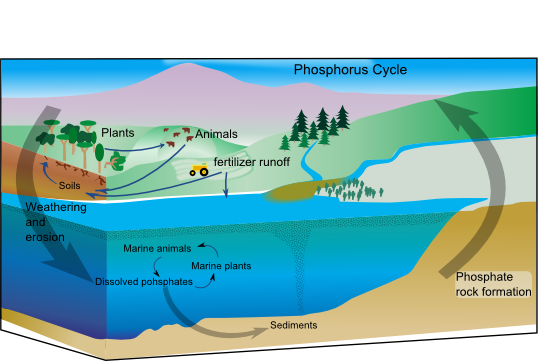Carbon and nitrogen are two elements that are the building blocks of life. Both have cycles that heavily involve the atmosphere as major reservoirs, and they share other similarities as well. Phosphorous and sulfur also cycle through ecosystems in cycles called sedimentary cycles in which the lithosphere serves as the primary reservoir.
Click each tab below to compare these two cycles.
Phosphorous Cycle
Sulfur Cycle

Phosphorous is an element especially important in cell DNA and is therefore critical for life. Phosphate is present in large amounts in rock and soil where it can remain for millions of years until it is released by weathering (the breakdown of rock and soil by precipitation and other forms of weather.) Phosphate then moves by runoff into bodies of water (human-introduced phosphate, again from fertilizer, also enters water in runoff.) It is then taken in by plants through their roots and enters animals when these plants are consumed. Decomposers reintroduce phosphate to the soil when they break down the tissues of dead plants and animals.

Like nitrogen, the element sulfur is an important part of many proteins. Like in the phosphorous cycle, the lithosphere is the largest reservoir of sulfur. Sulfur is introduced into an ecosystem through weathering of rock and through the disturbance of sediment at the bottom of oceans. Plants take up sulfur and use it as a building block for many of their cell structures. Animals assimilate sulfur when they consume plants. Decomposers do most of the natural work of introducing sulfur to an ecosystem, releasing the element in the form of hydrogen sulfide into the lithosphere, hydrosphere, and atmosphere as they break down dead plant and animal tissue. Humans have vastly upset the balance of many ecosystems by introducing sulfur into the atmosphere. Like carbon, it is released during the combustion of fossil fuels and is a major component of acid rain. Sulfur also enters the atmosphere by volcanic eruptions, by manufacturing processes, and in car exhaust.
Test your knowledge of the sedimentary cycles by answering these questions.
Where are the largest reservoirs for the phosphorous and sulfur cycles located?
- hydrosphere
- atmosphere
- lithosphere
- living things
Recall that this term also refers to a group of rocks.
Recall that this term also refers to a group of rocks.
Recall that this term also refers to a group of rocks.
Recall that this term also refers to a group of rocks.
How are phosphorous and sulfur returned to the soil?
- They are released through volcanic eruptions.
- They enter the soil when fossil fuels undergo combustion.
- They are released by the process of weathering.
- They reenter the ground from decomposing plant and animal tissue.
Organisms that contribute to this process include bacteria and fungi.
Organisms that contribute to this process include bacteria and fungi.
Organisms that contribute to this process include bacteria and fungi.
Organisms that contribute to this process include bacteria and fungi.
Summary
 Questions answered correctly:
Questions answered correctly:
 Questions answered incorrectly:
Questions answered incorrectly:
